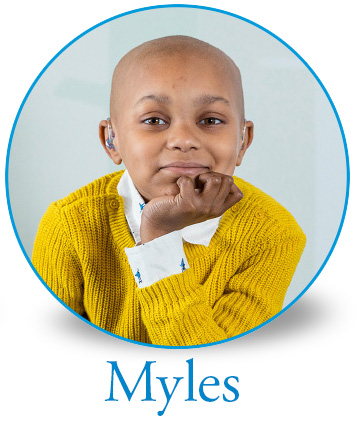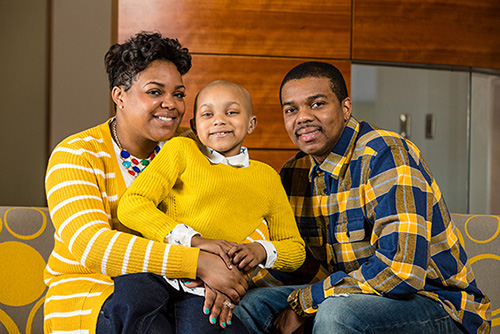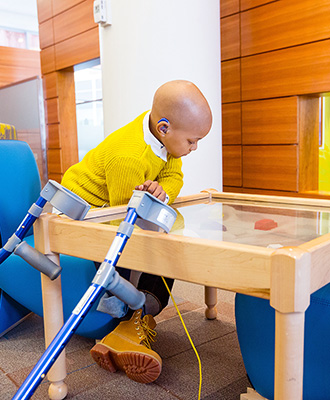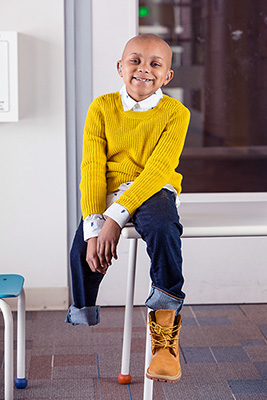Myles Davis
Cancer takes 7-year-old’s leg, but not his fighting spirit
 Eyelids drooping, arms limp, Myles Davis looks up at his nurse. He considers her question for a moment, but then casts his gaze downward and shakes his head.
Eyelids drooping, arms limp, Myles Davis looks up at his nurse. He considers her question for a moment, but then casts his gaze downward and shakes his head.
“Are you sure?” she asks. “This is the last chance to go to the playroom today!”
“Come on, buddy,” says his father, sitting next to his hospital bed. “It’ll be fun. They’ve got all those Legos down there.”
A frown crosses the 7-year-old’s face.
Reluctantly, he pulls himself to the edge of the bed. He braces himself with his left foot, then places the bottom of his right thigh on his prosthetic leg and steadies himself with his crutches.
But it’s not meant to be. After taking a step, Myles winces and turns back. He climbs into his bed again and lays his head on the pillow, turning his back to the door. His father’s pleas to get him to try again go unanswered, and the little boy closes his eyes.
‘What is going to happen?’
Chemotherapy is brutal. At best, it saps your strength, leaving you in bed for hours on end. In Myles’s case, it also came with a heavy dose of nausea. In the early going, the slightest whiff of virtually any smell would lead to vomiting.
“This is actually better than the chemo he had last year,” said Tillman ‘TJ’ Davis, Myles’s father. “He’s been taking to the medicine better.”
His parents know there’s a light at the end of the tunnel. The conversation that saw him crawl back into his hospital bed came on a day in February, when he had only three rounds of chemotherapy left. They also know that their son has come a long way since two summers ago, when he started to complain about some pain in his right leg.
 Myles had just graduated kindergarten and was flourishing—an energetic youngster who loved sports cars, Batman, and Legos, and who radiated happiness.
Myles had just graduated kindergarten and was flourishing—an energetic youngster who loved sports cars, Batman, and Legos, and who radiated happiness.
“It seemed like everything was just falling into place for him,” said Tillman Davis. But when the pain didn’t subside, and he started to limp, it became obvious that this wasn’t just a bad bruise. Soon, Myles was seeing specialists and getting scans.
The diagnosis was osteosarcoma, a cancerous tumor that often strikes teens and young adults but sometimes makes its way into the bones of children, as well. In Myles’s case, a growth the size of a golf ball had nestled its way into his fibula. Cancer. This wasn’t supposed to happen. Not to a five-year-old.
His parents’ thoughts lingered on what their future could bring.
“I can’t plan a funeral for my son. I can’t do those things. What is going to happen?” said Myles’s mother, Michaela. “That was the hardest day of my life.”
Myles’s oncology team at Golisano Children’s Hospital, led by Lauren Bruckner, MD, and Carol Fries, MD, started him on chemotherapy right away, hoping to shrink the tumor before surgery. In October 2016, Wakenda Tyler, MD, then an orthopaedic oncologist at Golisano Children’s Hospital, performed the operation.
Fortunately, his team was pleased with the outcome.
 “A big determinant of prognosis is whether the tumor can be fully removed, or if there’s some disease left behind,” said Fries, a second-year pediatric hematology/oncology fellow. “The removal of Myles’s tumor was fully successful, and it had been almost completely destroyed by the chemotherapy at the time of his surgery.”
“A big determinant of prognosis is whether the tumor can be fully removed, or if there’s some disease left behind,” said Fries, a second-year pediatric hematology/oncology fellow. “The removal of Myles’s tumor was fully successful, and it had been almost completely destroyed by the chemotherapy at the time of his surgery.”
A stubborn disease
The incision took a long time to heal, as Myles’s immune system was still being suppressed by the continuing chemotherapy. An infection and a blood clot in his leg slowed his recovery. But soon, he was starting physical therapy and learning to walk on his right leg again.
Last February, he finished chemotherapy. For the next six months, everything seemed normal. Myles returned to school and resumed his normal activities. That summer, the Make A Wish Foundation helped bring him and his family to Legoland.
But osteosarcoma is a stubborn disease, one of the few cancers that researchers haven’t made much progress on over the past few decades. Though Myles’s first tumor looked to be almost completely dead when it was removed—evidence that the chemotherapy was working well—his leg pain returned in September.
“He’d been fine. He was jumping all over the place,” said Tillman Davis. “But when he said ‘It’s hurting like before,’ that’s what signaled us.”
Scans revealed a new tumor in the same leg. Thankfully, there was no sign that the cancer had spread anywhere else in his body. But given the tumor’s location, just below his knee, the operation came with a sad consequence: Myles would have to lose his leg.
“Those decisions are never taken lightly,” said Fries. “It’s a tragedy for a child like Myles to have to go forward without his leg.”
But his parents had weighed all of the options, and knew that this was Myles’s best shot at survival. They sat down with their son and told him what was coming.
Myles understood.
“My leg was making me sick,” he said. “I didn’t want that leg to make me sick any more. So I’m just going to get a new leg.”
 In the year since his initial diagnosis, Myles’s surgeon had taken a new position at a hospital in New York City. Wanting the most continuity in his care as possible, his parents brought him there for his surgery. After the procedure, they immediately returned to Rochester so Myles could start another round of chemotherapy. His oncologists hoped that this final round would eradicate any remaining cancer cells that they couldn’t detect via scans. “We know the chemotherapy was working before, so I think any leftover cells in his body would respond,” said Fries. “We think the vascular damage in his leg may have affected blood flow, and perhaps the chemotherapy couldn’t reach the surgery site. That’s the working hypothesis, since we didn’t find it anywhere else.”
In the year since his initial diagnosis, Myles’s surgeon had taken a new position at a hospital in New York City. Wanting the most continuity in his care as possible, his parents brought him there for his surgery. After the procedure, they immediately returned to Rochester so Myles could start another round of chemotherapy. His oncologists hoped that this final round would eradicate any remaining cancer cells that they couldn’t detect via scans. “We know the chemotherapy was working before, so I think any leftover cells in his body would respond,” said Fries. “We think the vascular damage in his leg may have affected blood flow, and perhaps the chemotherapy couldn’t reach the surgery site. That’s the working hypothesis, since we didn’t find it anywhere else.”
Staying positive
Today, scans show no signs of cancer anywhere in Myles’s body. And aside from his crutches, there are no outward signs of it, either.
On a recent Saturday, Myles bounded through the Golisano Children’s Hospital lobby, easily outpacing a photographer who was trying to take his picture. Clearly adept with his crutches, he flew around the room, ducking around corners and launching himself over the furniture. In the rare instances when he needed to catch his breath, he slowed down and posed for the lens, cracking a huge smile and breaking out into laughter.
His parents know there’s a chance that the cancer could return. But they’re maintaining the same positive attitude that has helped them—and Myles—get this far.
“I just think we have a good team here. That’s why we feel comfortable,” said Tillman Davis. “We’ve felt informed the whole way, and the doctors and nurses here made us feel like part of the team. So we’re feeling very positive about it.”